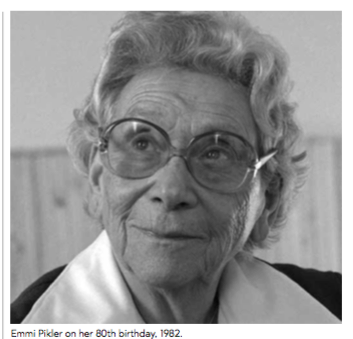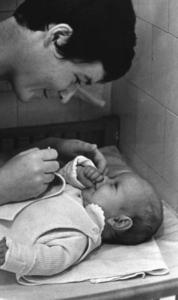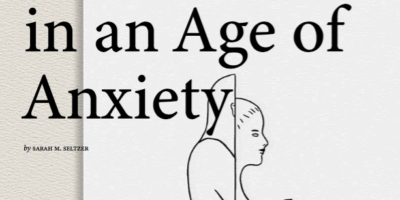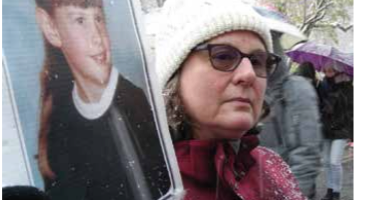
Interfere Less, Observe More
Dr. Emmi Pikler Revolutionized Orphan's Care. Why Her Ideas Matter Now.
 With all eyes riveted on images of babies and toddlers separated from their parents at the U.S.-Mexico border, and with thousands of these children placed in institutions or in last-minute foster-care arrangements, the patterns of caring for infants and children nearly 80 years ago have a lot to teach us today.
With all eyes riveted on images of babies and toddlers separated from their parents at the U.S.-Mexico border, and with thousands of these children placed in institutions or in last-minute foster-care arrangements, the patterns of caring for infants and children nearly 80 years ago have a lot to teach us today.
The images of crying refugee children accompanied 16 of us—parents and early childhood professionals from 10 countries—attending an annual weeklong seminar on how to best care for infants and toddlers at the Pikler House in Budapest, Hungary in June. It was my fifth year there. What keeps me coming back is the deep font of wisdom held by the experienced staff of this amazing place— wisdom that could well help U.S. officials now causing untold trauma to young children.
Today a day care, research and training center, the Pikler House—known as Lóczy, after the street on which it is located— was established by the visionary Jewish pediatrician Emmi Pikler as a residential infants’ home right after World War II at the request of the city of Budapest. Over more than 60 years, it functioned as a home for 2500 orphaned infants and young children and those whose parents could not care for them. Pikler applied her path-breaking approach there, documented the life of the children in photos and films, conducted research and published scientific papers. A 1968 World Health Organization study found that children reared at Lóczy turned into well adjusted adults—a stunning outcome for children raised in orphanages. Following that study, Lóczy became known as a model orphanage, and at the request of the Hungarian government, its staff regularly visited other orphanages to train them in the Piklerian approach.
What was so different about the way children at Lóczy were raised? What is it that keeps people—including seasoned professionals— from throughout the world flocking to the former mansion in the green hills of Budapest to learn Pikler’s approach?
The children at Lóczy were cared for with respect and sensitivity and were given the freedom to follow their own impulses in movement, play and exploration. This was in sharp contrast to babies in many other orphanages who were (and still are) kept in cribs all day, given bottles to drink by themselves, and roughly hurried through care routines.
I encountered Pikler’s ideas 33 years ago when my firstborn, Ilana, was three months old. I had travelled from my home on New York’s Upper West Side to visit family in my hometown of Los Angeles. A friend’s mother had been holding Ilana, and before returning her to my hands, she turned to the baby, looked her in the eyes, and said, “I’m giving you back to your Mummy now.” Then she turned to my friend and said, “Did I do that right?”
I was intrigued. It turned out my friend, Hari Grebler, was being trained by Emmi Pikler’s protégé Magda Gerber, who had founded Resources for Infant Educarers in Los Angeles. I visited the RIE Center, was inspired by what I saw and bought the only book on the Pikler approach that was then available in English. (Today, there are at least a dozen, including Dear Parent: Caring for Infants with Respect by Magda Gerber; Respecting Babies: A New Look at Magda Gerber’s RIE Approach by Ruth Anne Hammond; and Baby Knows Best by Deborah Carlisle Solomon.)
Pikler’s ideas resonated deep inside me and I started implementing them with Ilana and later with my two boys. Rather than trying to get care routines over with as fast as possible, I tried to slow down, connect with my babies and ask for their cooperation when I changed their diapers, bathed or dressed them. Whereas other moms around me strapped their babies into seats and swings and felt pressured to constantly entertain or stimulate their little ones, I gave mine lots of time on the floor to move and play freely. I saw that they were perfectly capable of and happy to stimulate and amuse themselves. The moms in my mother’s group would comment on how active Ilana was, not realizing that their babies, often propped up with cushions before they could sit on their own, were not free to move as they pleased in that position. Despite what I saw around me, I never sat them up before they could sit by themselves, or held their hands up to walk them before they walked on their own. I also didn’t interrupt their play. In short, I trusted that if my children got the love and attention they needed during care routines and at other times, they could be free during playtime to follow their own initiative. It would take them where they needed to go.
After we moved to Israel and once my youngest was old enough for me to leave home for a couple of weeks, I began traveling to Los Angeles and Budapest for training to become a parent educator in this approach. I wanted other parents to learn what I had learned and what felt so right. I’ve been teaching parent-baby classes inspired by the approach in Jerusalem since 2013. In August, I brought the first two-week RIE® Foundations™ training to Tel Aviv.
Who Was Emmi Pikler?
Born Emilie Madleine Reich in Vienna in 1902, Pikler was the only child of an Austrian mother and Hungarian father who moved with her to Budapest when she was six. Her mother, a kindergarten teacher, died when she was 12, a development that may have influenced her choice of profession and her passionate commitment to orphaned children. Her father, an artisan who manufactured baking implements, was, “a believer with a kippah,” according to his granddaughter, psychologist Anna Tardos.
Pikler attended medical school in her native Vienna during the 1920s, a time rich with post-World War I reformist ideas. She was influenced by the confluence of Marxism, psychoanalysis, the back-to-nature movement and the new education movement, which had roots in the thinking of Jean-Jacques Rousseau. That movement aimed for social change through education, saw children as equals and influenced Maria Montessori, Rudolf Steiner and Janusz Korczak. Pikler had the good fortune to be trained by doctors who saw the child as a whole person to be treated with respect.
When she began her private medical practice in Budapest in 1935, Pikler was more interested in promoting healthy physical and emotional development than in curing illnesses and, according to Tardos, her patients were rarely ill. During weekly home visits (as a Jew in Hungary, she was already prohibited from working in a hospital or other institution), Pikler advised parents to interfere less and observe more. She taught them to have a predictable rhythm to the day, enable their babies to move and play freely and to respect the children’s developmental timetable. She asked them to take their time during the caregiving routines, to respond to the child’s signals, to tell the child what they were doing each step of the way and to ask for the child’s cooperation. “I want to put your shirt on. Can you give me your hand?” She encouraged parents to follow the child’s lead when he moved and played during caregiving.
At the basis of Pikler’s philosophy is the view of a baby as a person. Of course a baby is person! you may be thinking. But how many times have you seen a parent or caregiver approach a baby and, without first saying a word about what is about to happen, simply scoop him up from behind and carry him to the changing table? Would we ever treat an adult so cavalierly?
Pikler encouraged her patients and caregivers to approach the child, see what he is doing, tell him she is going to change his diaper, hold out her hands to pick him up and wait for a response. She saw diapering and other care routines as critical components to building the parent/caregiver-child relationship and the child’s sense of security and confidence. Rather than something to be gotten through, the care routines were seen as golden opportunities for connection. Indeed, her principles of free movement and play were dependent on conducting the daily care routines of bathing, diapering, dressing, feeding and putting to sleep in a manner that was enjoyable for the infant and that deepened the relationship between him and his caregiver. In addition to this kind of quality time contributing to emotional stability and growth, Pikler sensed what research later proved: that social/emotional relations affect brain development. Indeed, psychologist and neuroscientist, Natasha Khazanov PhD, associate clinical professor at UC San Francisco, called Pikler “an incredible visionary (who was) ahead of her time.”
Pikler’s ideas went against prevailing child-rearing practices. She was opposed to binding babies in seats or other contraptions; placing them in positions they could not get into themselves; entertaining them constantly; jiggling toys in front of them; hanging mobiles over their heads and teaching them how to sit, walk and play.
“Dr. Pikler came out vehemently against the prevailing view of our time: to do with the baby what the adult wants—to dance with him, to sing to him, to throw him up in the air; to teach him to sit, to teach him to speak,” says Yardena Avi-Dor, who was a student of Pikler’s in the Seminary for Mothers and Teachers in Budapest in 1943. “She advocated letting the baby do what he wants at his own pace and not to struggle over food or toilet training.”
Although she was Jewish, and the Nazis were on Hungary’s doorstep, Avi-Dor said 1943 was the best year of her life.
“Europe was at war. We had no hope, no horizons,” Avi-Dor told Lilith. “But every one of the 23 Jewish girls in my class remembered it as the happiest year of her life. It changed our relationship with ourselves. Emmi Pikler turned our worldview on its head. I wasn’t the only one who had a stern, punishing mother, and suddenly we could breathe, we got respect. We grew up…She gave us back our childhood confidence.”
Training Jewish Girls — And Saving Them
I found Avi-Dor through a Google search in Hebrew for “Emmi Pikler.” She had been one of dozens of girls trained as caregivers by Pikler during World War II. In 1940, Pikler already had a reputation as an outstanding pediatrician and was well known through her popular Hungarian book on child-rearing (“What Can the Baby Already Do?”; in German, Peaceful Babies, Contented Mothers). That’s when Rabbi Dr. Imre Benechowki asked her to organize the curriculum and recruit teachers for the seminary he founded in response to the government’s almost total ban on Jewish high school graduates attending university. The seminary, which met in a basement on Tigris Street, was sponsored by the Jewish community of Buda and authorized by the Ministries of Education and Religion. Each year from 1940 to mid-1944, about 25 Jewish girls were trained at the seminary. One of them, Judit Falk, went on to become a pediatrician and directed Lóczy after Pikler retired.
I’m speaking to Avi-Dor, now in her late 80’s, in a café in downtown Jerusalem. White-haired and walking now with a cane, she is excited to be sharing memories from this formative time in her life.
“I could talk about what I learned from Pikler forever,” she said. “It’s as if there is a box in my head full of ancient treasures and suddenly the box opens and its contents spill out and I can’t stop the flow.”
Indeed, Avi-Dor remembers her training in great detail. She said the charismatic Pikler hired the best teachers of education, psychology, movement, crafts, philosophy, drawing, classical music and gardening—and even a teacher of children’s songs. And she taught there herself. She required that those of her students who had unresolved issues with their parents undergo psychoanalysis so they wouldn’t unconsciously act out their issues with the children who would be in their care.
“My mother called me bad, ugly, stupid,” said Avi-Dor. “The therapy saved me. I was allowed to feel what I felt. I began to accept myself.”
Pikler had definite views and not only about child rearing. “She wouldn’t allow us to take notes during class,” Avi-Dor said. “We were to listen, to look at the lecturer and only later at home, to write down what we remembered.” Avi-Dor continued this practice in her university and graduate studies in Israel.
The Hungarian seminary’s curriculum included progressive elements such as the movement education of “bodywork” pioneer, Elsa Gindler, whose work on sensory awareness influenced Wilhelm Reich, the radical physician, psychoanalyst and body therapy pioneer. Some of what went on in that seminary in the 1940’s resembles today’s hippest yoga studios. “Our exercise teacher, Lili Edelstein, said ‘Listen to the body, the body speaks’,” said Avi-Dor. “She taught us to lie down on the floor and relax, to pay attention to the breath.”
Forced to close the seminary in May 1944—six weeks after the Nazis invaded Hungary—Pikler used her connections with high officials to ensure that her students were hidden and/or given false papers if they weren’t spirited out of the country to safety.
“Emmi was very much in demand as a doctor, especially by government ministers, the aristocracy, members of parliament, all the big Nazis,” said Avi-Dor. “She was famous—a German speaking doctor with new methods. She used her connections to send everyone she could to safety. She placed my friend, who studied in the seminary the year before me, as a nanny at the home of the Hungarian justice minister, who had been her patient. Like the others, Osnat had forged papers.”
When asked if Pikler herself had forged the papers, Avi-Dor proudly said, “We did,” referring to her fellow progressive Zionist youth movement comrades. (Avi-Dor escaped Hungary with her youth movement in 1944 and reached Israel the same year.)
“We had two methods,” she continued. “The boys pretended to be drivers or warehouse workers and would steal blank documents from Interior Ministry warehouses. We girls would fill out the certificates and stamp them with the stamp of the Jewish National Fund. The police didn’t check that carefully. If they had, they would have realized… The smarter girls would stand in line at the Interior Ministry behind a person declaring a death and asking for the right forms, and listen for the name. It takes time to issue a death certificate and in the meantime, they would go to another department and ask for that person’s birth certificate.”
Two former patients provided false documents for Pikler, her daughter, Anna, and her husband’s parents (her husband was a political prisoner at the time). Anna acted as a nanny in one of the families and Pikler pretended to be a governess in the second family’s home. By October, Pikler had arranged for her daughter to join her in the home in which she was hiding. “I wasn’t allowed to call her Mommy,” Tardos recalled. The Piklers survived the war and continued living in Budapest.
Pikler’s Influence
Word of the work being done at Lóczy began to spread outside of Hungary in the 1970’s. Inspired by a visit, French psychiatrist and Holocaust survivor Myriam David and psychologist Geneviève Appell, wrote Lóczy: An Unusual Approach to Mothering in 1973, which spread Pikler’s ideas around the world. In the documentary film, “Lóczy, a Place to Grow” by Bernard Martino, David calls the caregivers there “angels serving humanity.” Indeed, we see the caregivers in the film providing care with exquisite attunement and even joy. (I saw the same attuned, sensitive, joyful care when I observed at Lóczy in 2007.) To achieve this extraordinary level of care, Pikler fired the experienced caregivers she had initially hired who were too set in their ways to learn a new approach, and engaged inexperienced high school graduates from the countryside who loved babies. Each of them went through a rigorous training and shadowing process, as do the caregivers at the Lóczy day care center today.
Today, Pikler’s influence is international, with the late Princess Diana’s niece, among thousands of others, being raised according to her principles of free movement, autonomous play and mindful caregiving. Over the years, thousands of early childhood professionals and parents from dozens of countries have flocked to Lóczy to observe and to attend training sessions and seminars. Others learn about the approach from the many books and films produced by Lóczy and RIE. Among Pikler devotees are many Waldorf and Montessori early childhood teachers. They say the Pikler approach is congruent with their philosophies and fills in the crucial birth to age three gap, which is not the focus of the other two approaches.
Says Liz Hagerman, a therapist, Pikler student and Waldorf teacher in Washington, D.C.: “Pikler is the ‘how to’ for Steiner’s ideas about supporting the development and well-being of the child from birth to three. It’s a perfect complement.” Pikler students who are Montessori trained agree, adding that both approaches emphasize respect for the child, self-initiated activities in a prepared environment and the importance of observation in enabling adults to understand and empathize with young children.
A growing number of day care centers—including in France, Belgium, Switzerland, Germany, the U.S., Australia, New Zealand, and even Israel—are also adopting Pikler’s recommendations. Her emphasis on primary caregiving and continuity of care (that is that children stay with the same caregiver throughout their day care years and that one caregiver be primarily responsible for each child) is finally being adopted by national early childhood organizations in the U.S. and elsewhere.
There is, however, some misunderstanding in many articles and blogs; it is simply incorrect that Pikler advised against picking up a crying child or singing or playing with one’s children.
Changed My Mothering
“I encountered Pikler’s ideas when my firstborn was an infant and they dramatically changed the trajectory of my mothering,” said Countess Karen Spencer, the late Princess Diana’s sister-in-law and one of People Magazine’s “25 women changing the world.”
“It was liberating to learn that my daughter could have time to explore on her own and that so long as I was really present during caregiving, it was okay for me to be getting on with everyday tasks in between those moments of togetherness. It was a framework that allowed me to cope with the 24/7 nature of motherhood. It took the pressure of constant perfection off and unlocked a very natural and connected relationship.” Inspired by what she learned, Spencer founded Whole Child International in order to improve conditions in childcare institutions around the world, using Pikler’s approach as her basic philosophy.
Emmi Pikler directed Lóczy for 33 years and continued to lecture and to conduct research and consultations after her retirement until shortly before her death in 1984. While she was invited to Israel by Feldenkrais practitioners, she never made it there. A handful of Israeli early childhood professionals, including Miri Keren, M.D., former president of World Association for Infant Mental Health, director of the Geha Infant Mental Health Unit and a lecturer at the Sackler Medical School, have traveled to Lóczy for trainings. Keren, who also is the consulting psychiatrist to a residential baby home in Tel Aviv, says, “This approach facilitates growth and well-being in infants, teaches parents to observe without intruding or overstimulating and is a tool for prevention. A number of these principles have been implemented in an Israeli residential nursery with positive impact on both infants and caregivers.”
Now widowed and living in a nursing home near her grandchildren in Jerusalem, Avi-Dor is gratified that Pikler’s ideas have spread around the world and that there are more than 450 mothers in a Pikler Facebook group in Israel, dozens who have participated in Pikler-inspired parent-child classes there and several Tel Aviv preschools that work to implement the approach.
“My studies with her were worth more than everything I learned in teachers’ seminary here in Israel, or at university for my master’s degree,” said Avi-Dor. “If not for Emmi, I could never have done what I did—working in special education with juvenile delinquents and being able to honor their spirit, to give them respect and a sense of security.
“It was the experience of my life.”
Ruth Mason is a journalist and certified parent educator living in Jerusalem. She works at Shatil and blogs at timesofisrael.com.




